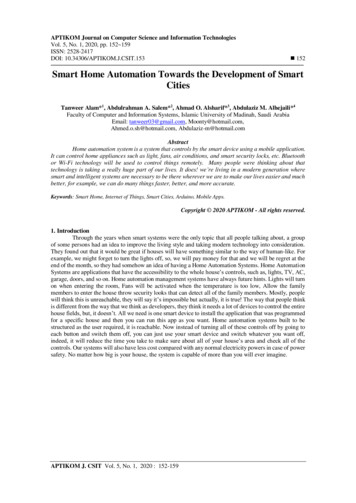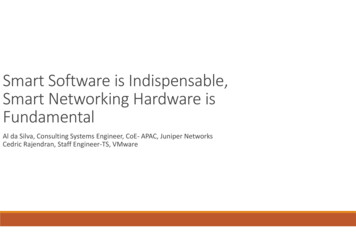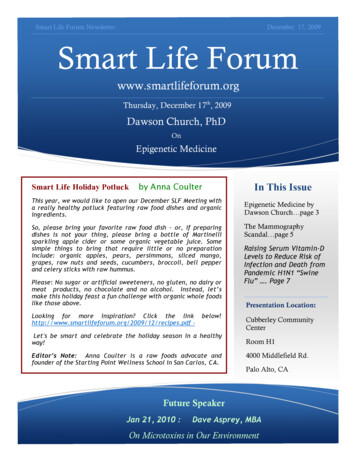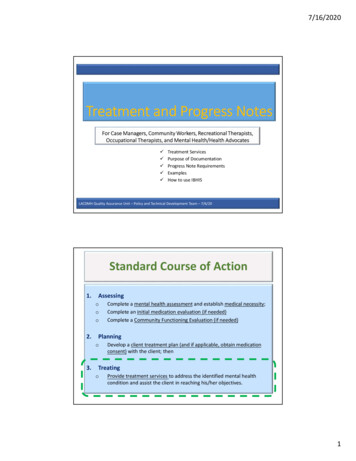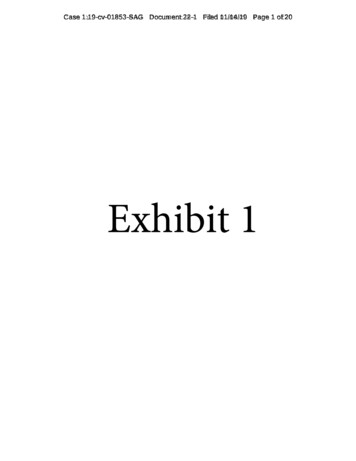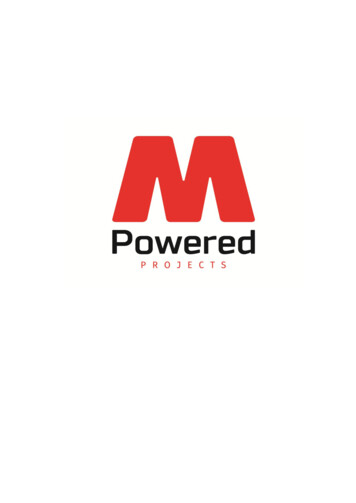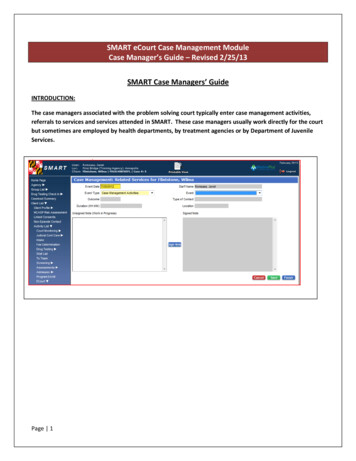
Transcription
SMART eCourt Case Management ModuleCase Manager’s Guide – Revised 2/25/13SMART Case Managers’ GuideINTRODUCTION:The case managers associated with the problem solving court typically enter case management activities,referrals to services and services attended in SMART. These case managers usually work directly for the courtbut sometimes are employed by health departments, by treatment agencies or by Department of JuvenileServices.Page 1
There are three different types of eCourt case management events (called Event Types on the data entry screen)in SMART. This document covers each of these three events in a separate section.EVENT TYPES:1. Case Management Activities:Defined as the “ECourt Case Management Event” where all thedocumentation of the communication and directives between the case manager and client, or betweenthe case manager and others working with the client, is recorded.2. Referral to Services: Defined as the “ECourt Case Management Event” where all referrals to Ancillary orCollateral Services by the case manager and the follow-up on the referrals by the client are documentedwithin SMART.3. Services:Defined as the “ECourt Case Management Event” where the client’s attendance at eachindividual Ancillary or Collateral Service is documented within SMART.1. CASE MANAGEMENT ACTIVITIES:Events are as follows:a) Case Management Planning is defined as any session where the client and the Case Manager developand update the goals and tasks and assignments of the Case Plan. This note should be formatted in thefollowing manner: Goal, Action, and Plan (GAP)b) Case Management Review (Progress Note) is defined as a written record completed at the end of asession where the Case Manager is managing, monitoring and/or evaluating the progress of a clientregarding the existing goals and tasks and assignments of the case plan. This note should be formattedin the following manner: Data, Action, Plan, and Results. (DAP)c) Contact with Treatment Provider is defined as a Case Management contact with any of the client’sTreatment Providers, such as mental health, medical, family therapy or substance abuse. This categoryrefers to contact with providers who have clinical licensure or certification. This contact shall beconducted by a face-to-face meeting, by phone, or a conversation through email.Writtencorrespondence through standard mail or fax is not considered a contact.d) Contact with Criminal Justice is defined as a Case Management Contact with the Probation Agent,State’s Attorney, Public Defender, or Private Counsel. This contact shall be conducted through either aface to face meeting, by phone, or email. Written correspondence through standard mail or fax is notconsidered a contact.e) Summary Note- is defined as the specific information provided in the public reporting section on theSMART Problem- Solving Court Report. This is not a progress note. The intention of the Summary NotePage 2
is to provide adequate, specific, and appropriate information for the purposes of a Problem solvingcourt Review Hearing in accordance with all consent(s) on file. For example, specific, confidential detailsof a session (clinical, non-clinical, or legal) should not be included within the Summary Note. Also, theSummary Note should not be used to manage the details of Case Management, Clinical, or LegalSessions. The “Court Report” is not to be substitution for case file documentation or a replacement ofPSC Team meetings or communication.f)Contact with Monitors – is defined as communication between the Case Manager and Public SafetyPersonnel. For example: Drug Driving Monitorsg) Contact with Collateral– is defined as a service or person serving to support or reinforce the needs ofthe client. This includes but is not limited to; Ancillary Services, Family, Parent or Guardian, nonCriminal Justice Services, or Employers.h) Exit Planning is defined as a process of monitoring and evaluating the client’s readiness for dischargefrom Problem solving court. Exit Planning is a process that begins at admission and includes; however,it is not limited to exercises in time, task and resource management, relapse management, successfulexecution of life skills, coping skills, support group participation, or mentor identification. Further, ExitPlanning is process whereby the Client and Case Manager prepare and implement strategies to decreasebarriers, improve behavioral responses to daily activities, decrease the influence of and improvereactions to triggers, and improve decision making and confidence. Measureable outcomes should beevident through the case notes kept by the Case Manager, and this information shall be used to supporta recommendation for graduation. In cases of poor performance or non-compliance, the detailed notesshould support a recommendation for termination.Progress notes may be associated with any of the above events except Summary Notes. Progress Notes aredefined as written records of any session where the Case Manager is managing, monitoring, and/or evaluatingthe progress of a client regarding the existing goals and tasks of the case plan. The detail includes the “data,action, plan, results”. (DAP)Outcomes for Case Management Activities are:a) Attended – Successful completion of an appointment, contact, or assignment (i.e. phone call received)b) Failure to Attend (FTA) – Failure to Attend a scheduled appointment or to complete a given assignment.c) Not Applicable (N/A) – For Case Management Summary Note or others as neededPage 3
d) Excused – Used in limited application to identify when a client has correctly addressed and/or rescheduled ascheduled appointment. (see program policy to define “correctly”)e) Unknown – Should be used very infrequentlyf) Blank – Missingg) Any other items in the dropdown list should not be used after 1/25/13.Outcome is currently a required field even though it is not shaded yellow.Types of Contact for Case Management Activities are: Face to Face: Client or professional communication in person at any designated location. Phone Contact: Client or professional communication through the telephone. Written, Email, and Text: Client or professional communication through email or text message. Any other items in the dropdown list should not be used after 1/25/13.Type of Contact is currently a required field even though it is not shaded yellow.Page 4
2. REFERRALS TO SERVICESWhen a case manager makes a referral to one of the services below, it should be documented in SMART withthe date the referral was made.Events are as Follows:Anger Management /Conflict ResolutionChild CareCommunity Service and Volunteer ProjectsDepartment of Labor, Licensing, and Regulation (DLLR)Developmental Disability ServicesEmployment ServicesFamily/Parenting CounselingGeneral Educational Development (GED)/Educational ServicesHigher Education and Vocational CollegesHobby/RecreationHousingHygiene – Personal Grooming & CareLegal Services (civil & criminal)Life Skills TrainingMedical Health Services (medical, dental, other)Mental Health ServicesMentorMoral Reconation Therapy (MRT)OtherParenting ClassesRecovery AdvocateSocial ServicesSubstance Abuse TreatmentSupport GroupsTransportationU. S. Department of Veterans Affairs (VA)Vital Statistics Agency – SSI, SSN, Driver’s LicenseVocational TrainingWomen's ServicesWork Preparedness Services - Clothing closets, pre-employment servicesWhen the case manager confirms that the client followed up at least once, it should be documented as follows:Outcomes for Referrals to Services are:The following outcomes are used to record the results of any referral to services.a) Attended– Used if the client has followed-up on the referral and attended at least one appointment withPage 5
the referral agency. This outcome should also be used if the client has successfully completed a givenassignment.b) Failure to Attend (FTA)– FTA to a scheduled appointment or to complete a given assignment.c) Not Applicable (N/A)d) Excused – Used in limited application to identify when a client has correctly addressed and/or rescheduled ascheduled appointment. (see program policy or define “correctly”)e) Unknown – Should be used very infrequentlyf)Blank – If outcome is unknown (expected to be completed when outcome is known)g) Any other items in the dropdown list should not be used after 1/25/13.Outcome is currently a required field even though it is not shaded yellow.Type of Contact for Referrals to Services are: Face to Face: Client or professional communication in person any designated location. Phone Contact: Client or professional communication by telephone. Written, Email, and Text: Client or professional communication through email or text message. Any other items in the dropdown list should not be used after 1/25/13.Type of Contact is currently a required field even though it is not shaded yellow.Page 6
3. SERVICES:When a case manager finds out that a client attended or did not attend one of the services below, it should bedocumented in SMART for the date the event was attended or scheduled for.Events are as follows:Anger Management /Conflict ResolutionChild CareCommunity Service and Volunteer ProjectsDepartment of Labor, Licensing, and Regulation (DLLR)Developmental Disability ServicesEmployment ServicesFamily/Parenting CounselingGeneral Educational Development (GED)/Educational ServicesHigher Education and Vocational CollegesHobby/RecreationHousingHygiene – Personal Grooming & CareLegal Services (civil & criminal)Life Skills TrainingMedical Health Services (medical, dental, other)Mental Health ServicesMentorMoral Reconation Therapy (MRT)OtherParenting ClassesRecovery AdvocateSocial ServicesSubstance Abuse Treatment (for treatment agencies not using SMART)Support GroupsTransportationU. S. Department of Veterans Affairs (VA)Vital Statistics Agency – SSI, SSN, & Driver’s LicenseVocational TrainingWomen's ServicesWork Preparedness Services - Clothing Closets, Pre-Employment ServicesOutcomes for Services are:The following outcomes should be used to record the results of any services.a) Attended– If the client attended the service. This outcome should also be used if the client has successfullycompleted a given assignment.b) Failure to Attend (FTA)– FTA to a scheduled appointment or to complete a given assignment.c) Not Applicable (N/A)Page 7
d) Excused – Used in limited application to identify when a client has correctly addressed and/or rescheduleda scheduled appointment. (see program policy or define “correctly”)e) Unknown – Should be used very infrequentlyf)Blank – If outcome is unknown (expected to be completed when outcome is known)g) Any other items in the dropdown list should not be used after 1/25/13.Outcome is currently a required field even though it is not shaded yellow.Type of Contact for Services are: Face to Face: Client or professional communication in person any designated location. Phone Contact: Client or professional communication by telephone. Email and Text: Client or professional communication through email or text message. Any other items in the dropdown list should not be used after 1/25/13.Type of Contact is currently a required field even though it is not shaded yellow.For all Event Types: (optional fields)Duration: Time spent on the activity in hours and minutesUnsigned and Signed Notes: Can be used to document what transpired during an event. Signing notes causesthem to be date and time-stamped with the time signed as well as with the SMART user’s name. Only signedcase management summary notes will appear on the Client Progress Report and Summary Report. Othersigned notes will appear on the report of Case Management Activities, both within an agency and in otheragencies where a valid consent is in place, but not on the Client Progress Report. NOTE: Check with OPSC tosee when these notes are required.Location: Is always grayed out. Users are never able to enter data in this field. If this field is needed, we canaddress opening it up for data entry.Modifying or Deleting Case Management EntriesTo modify an entry (i.e. to add an outcome) click “review” next to the activity on the eCourt Case Managementscreen. Then make the needed changes and save.To delete an entire case management event, referral, or service click “delete” next to the activity on the eCourtCase Management Screen. SMART will ask you if you are sure you wish to delete this event. If you are sure,press “yes”, this will delete the activity and then you must completely re-enter the note if you decide it isneeded.Page 8
AVAILABLE REPORTS:1. Client Progress Report – lists all case management events within a certain period, but does not displayany notes, except for summary notes. (See Attachment A)2. Print Report – Prints all fields on screen including signed notes for any Case Management Activity.However, one cannot limit the date range; therefore, all Case Management Activities for a given clientwill be displayed starting from the client’s admission into Problem solving court. (This report will have adate selection option by March 2013) This report is also available for consented data from theconsented activity list.3. Performance Reports from SSRS – Tables 7-9 report on Case Management activities as described below.See Attachment B for sample reports.Page 9
4. Ad Hoc Report from SSRS – There is a case management listing report by date as described below.lThis report will only show events entered into the agency requesting the report (i.e. no consented data). SeeAttachment C for a sample report.5. Excel spreadsheet report from SMART – Agency Reporting. Click Export to download the data to Excel, whereusers can analyze and format data.Page 10
evident through the case notes kept by the Case Manager, and this information shall be used to support a recommendation for graduation. In cases of poor performance or non-compliance, the detailed notes should support a recommendation for termination. Progress notes may be asso
